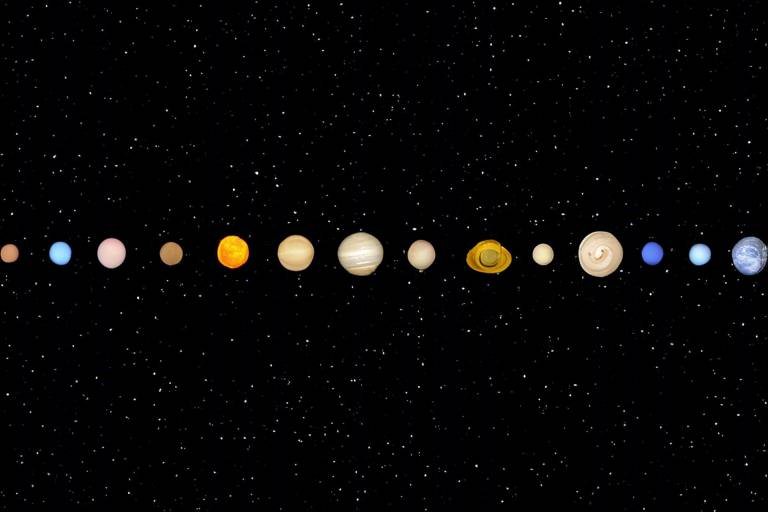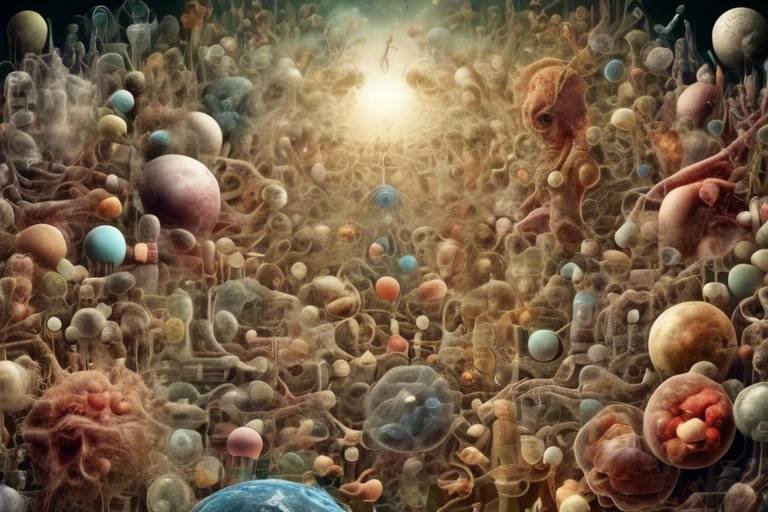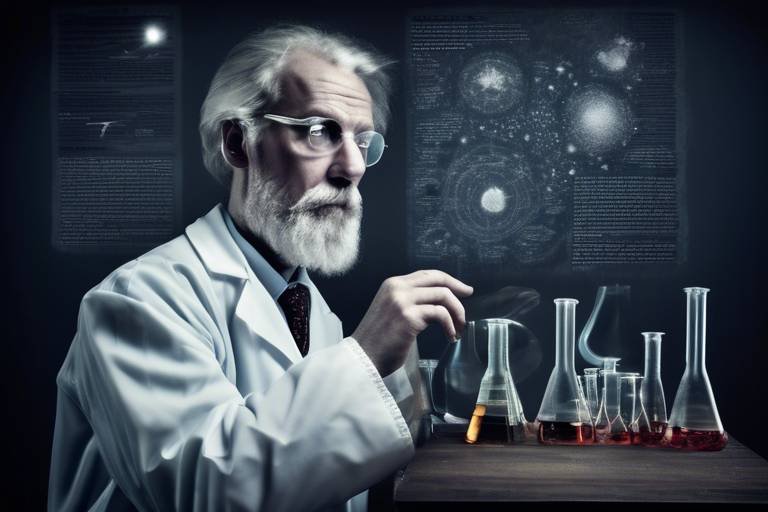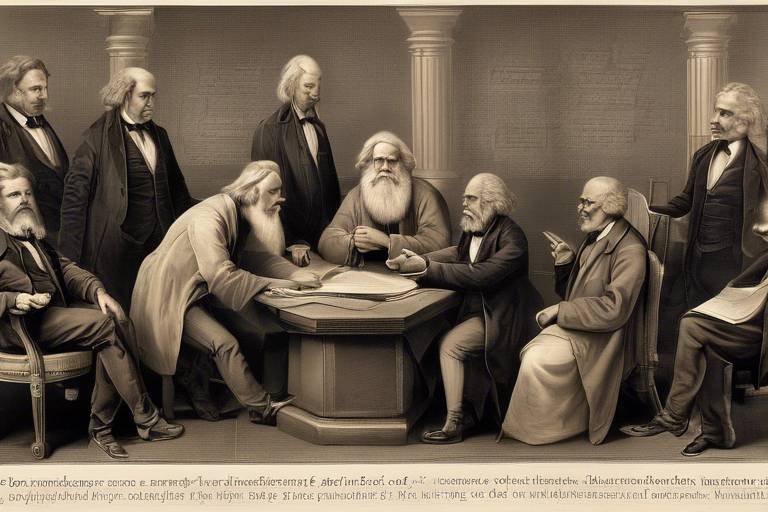The Scientific Method - A Philosophical Analysis
The scientific method is not just a series of steps; it's a profound approach to understanding the universe around us. It serves as a bridge between our **curiosity** and the **complexity** of reality. By systematically questioning, observing, and testing, scientists have unveiled mysteries that once seemed impenetrable. But what lies beneath this structured approach? How does it shape our perception of knowledge and truth? In this article, we will dive deep into the philosophical implications of the scientific method, exploring its principles, limitations, and the impact it has on our quest for knowledge.
The roots of the scientific method can be traced back to ancient civilizations, where early thinkers began to employ systematic approaches to understanding the natural world. The likes of **Aristotle** and **Galileo** paved the way for what we now recognize as modern science. Aristotle's emphasis on observation and classification laid the groundwork for empirical research, while Galileo's experiments challenged existing dogmas, showcasing the power of **critical thinking**. As we journey through history, we see how the scientific method evolved, influenced by key figures like **Francis Bacon**, who championed inductive reasoning, and **René Descartes**, who introduced skepticism as a tool for inquiry. This evolution reflects a shift from philosophical speculation to evidence-based reasoning, setting the stage for a more rigorous exploration of the world.
At its core, the scientific method consists of several essential components that guide researchers in their quest for knowledge. These elements include **observation**, **hypothesis formulation**, **experimentation**, and **analysis**. Each component plays a crucial role in the overall process, contributing to a systematic approach that helps to uncover the truth. Let's break down these elements further to understand their significance in scientific inquiry.
Observation is the very first step in the scientific method, acting as the spark that ignites curiosity. It involves gathering information through our senses or instruments. But why is observation so vital? Think of it as laying the foundation of a house. Without a solid foundation, the entire structure is at risk. When scientists observe phenomena, they begin to formulate questions that lead to deeper inquiries. For instance, a biologist observing a peculiar behavior in animals might wonder, "What triggers this behavior?" This inquiry is what drives the scientific process forward.
Observations can be categorized into two main types: **qualitative** and **quantitative**. Qualitative observations describe characteristics or qualities, such as color or texture, while quantitative observations involve measurements and numerical data, like height or weight. Both types are significant in scientific research, as they provide a comprehensive view of the phenomena being studied. For example, when studying plant growth, a scientist might note the color of the leaves (qualitative) and measure their height (quantitative). Together, these observations create a more complete picture.
Inquiry is the engine that drives scientific exploration. Asking the right questions is crucial, as it determines the direction of research. Just like a detective piecing together clues, scientists must formulate questions that lead to meaningful investigations. The quality of these questions can significantly impact the outcome of experiments. For instance, instead of asking, "Why do plants grow?" a more focused inquiry would be, "How does light intensity affect plant growth?" This precise questioning can lead to targeted hypotheses and experiments, ultimately advancing our understanding of the biological world.
Once observations and inquiries have been made, the next step is to formulate hypotheses. A hypothesis is essentially an educated guess, a testable prediction based on the observations. It serves as a guiding light for researchers, directing their experiments and analyses. The process of creating a hypothesis is akin to drawing a roadmap before embarking on a journey. For example, if a scientist observes that plants in sunlight grow taller than those in the shade, they might hypothesize that "increased sunlight exposure leads to greater plant growth." This hypothesis can then be tested through experimentation, providing a pathway to discovery.
Designing experiments is a critical aspect of the scientific method. A well-structured experiment allows researchers to isolate variables and draw valid conclusions. Key principles in experimental design include the use of **control groups**, identification of **variables**, and ensuring **reproducibility**. Each of these elements plays a vital role in maintaining the integrity of scientific research.
Control groups are essential in experiments as they provide a baseline for comparison. By keeping certain variables constant, scientists can observe the effects of the independent variable more clearly. For instance, if a researcher is studying the impact of fertilizer on plant growth, they would have one group of plants that receives fertilizer and another that does not. This comparison helps to validate the results and ensures that any observed changes are due to the treatment being tested.
Reproducibility is the cornerstone of scientific credibility. It refers to the ability of other researchers to replicate the results of an experiment under the same conditions. This principle is crucial for verifying the findings and building a robust body of scientific knowledge. If an experiment cannot be reproduced, it raises questions about the validity of the original results. In essence, reproducibility acts as a **safeguard** against errors and biases, ensuring that scientific discoveries are reliable and trustworthy.
- What is the scientific method? The scientific method is a systematic approach to inquiry that involves observation, hypothesis formulation, experimentation, and analysis to understand natural phenomena.
- Why is observation important? Observation is the foundational step in the scientific method, leading to inquiries that drive research and discovery.
- What is a hypothesis? A hypothesis is a testable prediction based on observations that guide scientific experiments.
- What are control groups? Control groups are essential in experiments as they provide a baseline for comparison, helping to validate the results.
- Why is reproducibility important? Reproducibility ensures that scientific findings are reliable and can be verified by other researchers, thus strengthening the credibility of scientific knowledge.

The Origins of the Scientific Method
The scientific method, a systematic approach to inquiry and experimentation, has roots that stretch back to ancient civilizations. It is fascinating to consider how this method, which is now the backbone of modern science, evolved through the contributions of numerous thinkers over centuries. The journey begins in ancient Greece, where philosophers like Aristotle laid the groundwork for empirical observation. Aristotle's insistence on observing nature and documenting findings was revolutionary, encouraging a shift away from purely speculative reasoning.
Fast forward to the Renaissance, a period marked by a resurgence of interest in science and the natural world. Thinkers such as Galileo Galilei and Francis Bacon played pivotal roles in shaping the scientific method as we know it today. Galileo's use of experimentation and mathematics to validate his theories on motion and astronomy was groundbreaking. He famously declared, “All truths are easy to understand once they are discovered; the point is to discover them.” This sentiment encapsulates the essence of the scientific endeavor—seeking truth through structured inquiry.
Meanwhile, Francis Bacon introduced the idea of inductive reasoning, which emphasized gathering data and forming generalizations based on observed patterns. He argued that knowledge should be derived from experience rather than relying solely on ancient texts or philosophical speculation. Bacon’s work laid the foundation for the modern scientific approach, advocating for a methodical and skeptical examination of the world around us.
In the 17th century, the scientific method began to take a more formal shape with the contributions of René Descartes and the establishment of systematic experimentation. Descartes’ famous dictum, “I think, therefore I am,” highlights the importance of doubt and questioning in the pursuit of knowledge. His Cartesian method encouraged scientists to break down complex problems into simpler parts, facilitating a clearer understanding of the natural world.
As we moved into the 18th century, the scientific method continued to evolve. The Enlightenment brought forth a wave of intellectual rigor, with figures like Isaac Newton synthesizing the principles of mathematics and physics into a cohesive framework. Newton’s laws of motion and universal gravitation were not merely theoretical constructs; they were the result of meticulous observation and experimentation, embodying the very essence of the scientific method.
Today, the scientific method is recognized as a dynamic process, continuously refined and adapted to meet the challenges of modern science. It is no longer a linear path but rather a complex interplay of observation, hypothesis, experimentation, and analysis. This evolution reflects the growing understanding that knowledge is not static; it is a living entity that thrives on inquiry and revision.
In summary, the origins of the scientific method can be traced through a rich tapestry of historical figures and philosophical shifts. From the empirical observations of Aristotle to the structured experimentation of Newton, each contributor has played a vital role in shaping our understanding of the natural world. The scientific method stands as a testament to human curiosity and the relentless pursuit of knowledge, reminding us that with every question we ask, we inch closer to uncovering the mysteries of the universe.

Key Components of the Scientific Method
The scientific method is not just a series of steps; it’s a dynamic process that fuels the engine of discovery. At its core, it comprises several key components that work together to build a robust framework for scientific inquiry. These components include observation, hypothesis formulation, experimentation, and analysis. Each element plays a crucial role in unraveling the mysteries of the natural world and advancing our understanding of complex phenomena.
Let’s start with observation. This is where it all begins! Scientists immerse themselves in the world around them, keenly observing and gathering data. It’s like being a detective, where every detail counts. Observations can be made through various methods, and they often lead to intriguing questions. These questions are the seeds from which hypotheses sprout. A hypothesis is essentially a testable prediction, a way for scientists to make educated guesses about the outcomes of their inquiries. It’s like saying, “If I drop this ball, it will fall to the ground.”
Next comes experimentation. This is where the magic happens! Scientists design experiments to test their hypotheses. It’s essential to have a well-structured experiment, which involves creating a controlled environment where variables can be manipulated. Think of it as a cooking recipe; if you change one ingredient, you might end up with a completely different dish! In scientific experiments, the variables can be categorized into independent and dependent variables. The independent variable is what you change, while the dependent variable is what you measure. This careful manipulation helps scientists draw meaningful conclusions.
Finally, we arrive at analysis. After conducting experiments, scientists collect data and analyze the results. This step is crucial as it helps determine whether the hypothesis is supported or refuted. It’s like piecing together a puzzle; the data must fit together to reveal a coherent picture. Statistical methods often come into play here, allowing scientists to quantify their findings and assess their significance. Without proper analysis, the entire experiment could be rendered meaningless.
To sum it up, the key components of the scientific method form a cohesive cycle that propels scientific knowledge forward. Each component is interconnected, and the process is iterative. Scientists often revisit earlier stages based on new findings, which leads to deeper insights and further questions. This is the beauty of science—it’s a never-ending quest for understanding, where every answer uncovers new mysteries.
- What is the scientific method? The scientific method is a systematic approach used by scientists to explore observations, answer questions, and test hypotheses through experimentation and analysis.
- Why is observation important in the scientific method? Observation is crucial as it provides the groundwork for formulating questions and hypotheses, guiding the direction of scientific inquiry.
- What role do hypotheses play in scientific research? Hypotheses serve as testable predictions that scientists can investigate through experiments, helping to validate or challenge existing knowledge.
- How do scientists ensure their experiments are valid? By using control groups, manipulating variables carefully, and ensuring reproducibility, scientists can validate their experimental results.

Observation and Inquiry
Observation is the very heartbeat of the scientific method. It’s like the first step in a thrilling treasure hunt, where each clue leads to a deeper understanding of the world around us. When scientists observe, they are not just passively looking; they are actively engaging with their environment, asking questions, and seeking patterns. This initial inquiry is vital because it sets the stage for everything that follows. Without keen observation, hypotheses remain mere fantasies, untested and unfounded.
Imagine you’re a detective in a mystery novel. You don’t just walk into a room and guess what happened; you observe every detail—the color of the walls, the placement of furniture, the expressions on people’s faces. Similarly, scientists use observation to gather data, which is the foundation for formulating hypotheses. This process can be both qualitative and quantitative. Qualitative observations might include descriptions of color, texture, or behavior, while quantitative observations involve numerical measurements, such as temperature or mass.
Understanding the types of observations helps clarify how scientists gather information. Here’s a quick breakdown:
- Qualitative Observations: These are descriptive and involve characteristics that can be observed but not measured. For example, noting that a plant is wilting or that a chemical reaction produces a colorful gas.
- Quantitative Observations: These involve numerical data and can be measured. For instance, measuring the height of a plant in centimeters or recording the temperature of a solution in degrees Celsius.
Both types of observations are crucial. While qualitative data provides context and depth, quantitative data offers precision and clarity. Together, they paint a comprehensive picture that guides scientific inquiry.
Now, let’s talk about inquiry. Why is asking the right questions so important? Think of inquiry as the compass that directs a scientist's journey. Without it, you could easily get lost in a sea of data. The right questions not only guide research but also ignite curiosity and drive exploration. When scientists ask, “What if?” or “Why does this happen?” they open doors to new possibilities. This inquisitive mindset fosters innovation and pushes the boundaries of what we know.
Moreover, inquiry is not a one-time event. It is an ongoing dialogue between observation and experimentation. Each answer leads to new questions, creating a cyclical process that fuels scientific discovery. For example, after observing a phenomenon, a scientist might formulate a hypothesis, conduct experiments, and then return to observation to analyze the results. This iterative nature is what makes the scientific method so powerful and dynamic.
In conclusion, observation and inquiry are the twin pillars of the scientific method. They are interdependent, each enhancing the other to create a robust framework for understanding our world. As we continue to explore the mysteries of nature, let’s remember that every great discovery begins with a simple question and a keen eye.
1. What is the difference between qualitative and quantitative observations?
Qualitative observations are descriptive and focus on characteristics that cannot be measured, while quantitative observations involve numerical data and measurements.
2. Why is observation important in the scientific method?
Observation is crucial because it forms the basis for inquiry and hypothesis formation. It helps scientists identify patterns and anomalies that require further investigation.
3. How does inquiry drive scientific discovery?
Inquiry encourages scientists to ask questions, leading to hypotheses and experiments. This process fosters a deeper understanding of phenomena and can result in groundbreaking discoveries.

Types of Observations
When diving into the world of scientific research, it's essential to understand that not all observations are created equal. They can be broadly categorized into two main types: qualitative and quantitative. Each type plays a unique role in shaping our understanding of phenomena and guiding the scientific inquiry process.
Qualitative observations are all about the quality of what we perceive. Think of them as the rich, colorful brush strokes on a canvas that bring a painting to life. These observations involve descriptive attributes, which can include characteristics such as color, texture, smell, and taste. For instance, if a scientist is studying a new species of flower, they might note the vibrant hues of its petals or the sweet fragrance it emits. Such observations are crucial because they provide context and depth to the data being collected, allowing researchers to formulate hypotheses that are grounded in real-world experiences.
On the other hand, quantitative observations are like the precise measurements on a ruler, offering concrete data that can be analyzed statistically. These observations involve numerical values and are often used to quantify variables in an experiment. For example, if the same scientist were measuring the height of different flower species, they would record specific numbers, such as "10 cm" or "15 cm." This type of data is essential for conducting experiments where precision is key, as it allows researchers to identify patterns, make predictions, and ultimately draw conclusions based on statistical analysis.
Both types of observations are vital in the scientific method, and they often work hand-in-hand. A good scientist knows how to blend qualitative and quantitative observations to paint a fuller picture of the research question at hand. For example, while studying the effects of sunlight on plant growth, a scientist might observe that plants exposed to more sunlight not only grow taller (quantitative) but also exhibit a richer green color (qualitative). This dual approach enriches the research and helps build a robust framework for further exploration.
In summary, understanding the different types of observations can significantly enhance the quality of scientific research. By combining the descriptive richness of qualitative data with the numerical precision of quantitative data, scientists can develop a more comprehensive understanding of the phenomena they study. This synergy not only aids in hypothesis formulation but also in drawing meaningful conclusions that can advance our knowledge and understanding of the natural world.
- What is the difference between qualitative and quantitative observations?
Qualitative observations are descriptive and focus on qualities, while quantitative observations are numerical and focus on measurements. - Why are both types of observations important in scientific research?
They provide a comprehensive understanding of the research question, allowing for more robust hypotheses and conclusions. - Can qualitative observations be quantified?
While qualitative observations are inherently descriptive, researchers can sometimes assign numerical values to certain qualitative attributes for analysis.

Importance of Inquiry
Inquiry is the lifeblood of the scientific method; it’s the spark that ignites the flames of discovery and innovation. Imagine walking into a dark room without any light. What do you do? You start asking questions—where’s the light switch? What’s blocking the light? This is precisely how inquiry works in science. It’s about asking the right questions that lead us down the path of exploration. Without inquiry, we would be like ships lost at sea, drifting aimlessly without a compass.
The significance of inquiry in scientific exploration cannot be overstated. It serves as the foundation upon which hypotheses are built and experiments are designed. When scientists observe a phenomenon, the first instinct is to ask, "Why is this happening?" or "What causes this effect?" These questions are not just idle thoughts; they are the beginning of a structured approach to understanding the universe. Inquiry drives the scientific process forward, allowing us to peel back the layers of complexity surrounding natural phenomena.
Moreover, inquiry fosters critical thinking. It encourages scientists to challenge existing paradigms and to think outside the box. For instance, consider the groundbreaking work of scientists like Galileo and Newton. Their inquiries led to revolutionary changes in our understanding of physics and astronomy. By questioning the status quo, they opened new avenues for exploration and paved the way for future generations of scientists.
In a practical sense, inquiry can be categorized into different types, each serving a unique purpose in scientific research. These include:
- Descriptive Inquiry: This involves asking questions to describe phenomena, often leading to observational studies.
- Comparative Inquiry: This type involves comparing different variables to understand relationships and differences.
- Experimental Inquiry: Here, questions are formulated to test hypotheses through controlled experiments.
Each type of inquiry plays a crucial role in shaping scientific knowledge. When scientists engage in inquiry, they not only seek answers but also learn to appreciate the complexity of the world around them. This appreciation is vital, as it nurtures a sense of curiosity and wonder, which is essential for scientific advancement.
In conclusion, inquiry is more than just a step in the scientific method; it is the engine that drives scientific discovery. It leads to new ideas, challenges existing knowledge, and ultimately contributes to our understanding of the universe. As we continue to ask questions, we illuminate the darkness of ignorance and pave the way for future discoveries. So, the next time you find yourself faced with a mystery, remember the power of inquiry—it just might lead you to uncover something extraordinary!
- What is the scientific method? The scientific method is a systematic approach to inquiry that involves observation, hypothesis formulation, experimentation, and analysis to understand natural phenomena.
- Why is inquiry important in science? Inquiry is essential as it drives the process of discovery, encourages critical thinking, and helps formulate hypotheses that lead to scientific advancements.
- How does one formulate a good scientific question? A good scientific question should be clear, focused, and researchable, often arising from observations or existing knowledge gaps.

Formulating Hypotheses
Formulating hypotheses is a critical step in the scientific method, acting as a bridge between observation and experimentation. When scientists observe a phenomenon, they are often struck by questions that bubble to the surface, igniting their curiosity. This is where the magic begins! A hypothesis is essentially a testable prediction about the relationship between variables, crafted from the insights gained during the observation phase. But how do we go from mere observations to creating a robust hypothesis? It's like taking a leap of faith into the unknown, armed with the best guess based on what we know.
To formulate a hypothesis, scientists typically start by asking themselves a series of questions. These questions are not just random musings; they are focused inquiries that aim to clarify the issue at hand. For example, if a scientist notices that plants in direct sunlight seem to grow faster than those in the shade, they might ask, "What role does sunlight play in plant growth?" From there, they can formulate a hypothesis such as, "If plants receive more sunlight, then they will grow taller compared to those that receive less sunlight." This hypothesis is not only clear and concise but also sets the stage for further investigation.
It's important to remember that a good hypothesis should be specific and measurable. This means that it should predict an outcome that can be tested through experimentation. Think of it as laying down the tracks for a train; without a clear path, the train (or in this case, the scientific inquiry) can easily go off course. A well-structured hypothesis not only guides the direction of the research but also helps in identifying the variables involved. For instance, in our plant growth example, the independent variable is the amount of sunlight, while the dependent variable is the height of the plants.
Moreover, hypotheses can be classified into two main types: null hypotheses and alternative hypotheses. The null hypothesis typically states that there is no effect or no difference, serving as a baseline for comparison. In our example, the null hypothesis would be, "Sunlight has no effect on plant height." On the other hand, the alternative hypothesis posits that there is indeed an effect, which in this case is that increased sunlight leads to taller plants. This duality in hypothesis formulation allows scientists to approach their experiments with a balanced perspective, ensuring that they can either support or refute their initial assumptions based on empirical evidence.
In summary, formulating hypotheses is not just about making educated guesses; it's about creating a framework for scientific inquiry. A well-crafted hypothesis can illuminate the path to discovery, guiding researchers through the labyrinth of experimentation. It's the spark that ignites the flame of knowledge, allowing scientists to explore the mysteries of the universe with clarity and purpose. So, the next time you find yourself pondering a scientific question, remember that formulating a hypothesis is your first step towards uncovering the truth!
- What is a hypothesis? A hypothesis is a testable prediction about the relationship between variables in a scientific study.
- Why is a hypothesis important? It provides a clear direction for research and experimentation, helping to focus the investigation.
- Can a hypothesis be proven true? While a hypothesis can be supported by evidence, it cannot be definitively proven true; it can only be supported or refuted based on experimental results.
- What are the types of hypotheses? The two main types are null hypotheses (which state no effect) and alternative hypotheses (which state there is an effect).

Experimental Design and Methodology
When it comes to the scientific method, experimental design and methodology are the backbone of any research endeavor. Think of it as the blueprint for a house; without a solid plan, the structure can easily collapse. In essence, experimental design refers to how researchers structure their experiments to ensure that they can accurately test their hypotheses. This involves careful planning and consideration of various factors that could influence the outcome of the experiment.
One of the key principles in experimental design is the use of control groups. A control group serves as a baseline that researchers can compare against the experimental group, which is exposed to the variable being tested. This comparison is crucial because it helps to isolate the effects of the independent variable on the dependent variable. For instance, if a scientist is testing a new drug, the control group would receive a placebo while the experimental group receives the actual drug. This way, any differences in outcomes can be attributed to the drug itself rather than other external factors.
In addition to control groups, understanding variables is essential in experimental design. Variables can be classified into three main types:
- Independent Variables: These are the factors that the researcher manipulates to observe the effect.
- Dependent Variables: These are the outcomes that are measured in the experiment.
- Controlled Variables: These are the factors that are kept constant to ensure a fair test.
By carefully controlling these variables, researchers can draw more reliable conclusions from their experiments.
Another critical aspect of experimental design is reproducibility. In the scientific world, reproducibility is a hallmark of credible research. It refers to the ability of other scientists to replicate the results of an experiment using the same methodology. If an experiment cannot be reproduced, it raises questions about the validity of the findings. This is why detailed documentation of the experimental process is vital. Researchers must provide clear descriptions of their methods, including how they selected their sample, the procedures they followed, and the statistical analyses they performed.
Moreover, the importance of randomization in experimental design cannot be overstated. Randomization helps to eliminate bias and ensures that the results are generalizable. For example, if a researcher is conducting a clinical trial, randomly assigning participants to either the control or experimental group minimizes the chances of confounding variables influencing the results. This fairness in assignment enhances the integrity of the research.
In summary, are crucial components of the scientific method that ensure research is conducted systematically and reliably. By employing control groups, understanding variables, emphasizing reproducibility, and utilizing randomization, scientists can build a robust framework for their experiments. This framework not only enhances the credibility of their findings but also contributes to the larger body of scientific knowledge.
Q: What is the purpose of a control group?
A: The control group serves as a baseline for comparison, allowing researchers to determine the effect of the independent variable on the dependent variable.
Q: Why is reproducibility important in scientific research?
A: Reproducibility ensures that findings are reliable and can be confirmed by other researchers, which is essential for building trust in scientific knowledge.
Q: How do researchers ensure their experiments are unbiased?
A: Researchers can minimize bias through randomization, which helps to ensure that each participant has an equal chance of being assigned to any group in the experiment.

Control Groups and Variables
In the realm of scientific experimentation, the concepts of control groups and variables are fundamental to ensuring the validity and reliability of results. Imagine you're baking a cake: if you change the recipe by adding an extra egg, how do you know if the cake is fluffier because of that egg or if it was just a fluke? This is where control groups come into play. A control group serves as a baseline, allowing scientists to compare the effects of the variable being tested against a group where that variable is not applied. By isolating the impact of the variable, researchers can draw more accurate conclusions about its effects.
Variables in an experiment are anything that can change or be changed. They can be categorized into different types, primarily independent and dependent variables. The independent variable is what you manipulate in the experiment, while the dependent variable is what you measure or observe. For instance, if you were studying how different amounts of sunlight affect plant growth, the amount of sunlight would be the independent variable, and the growth of the plants would be the dependent variable. Understanding the relationship between these variables is crucial, as it helps scientists establish cause-and-effect relationships.
To illustrate the importance of control groups and variables, let’s consider a simple experiment designed to test the efficacy of a new fertilizer. In this experiment, you might set up two groups of identical plants:
| Group | Fertilizer Treatment | Growth Measurement |
|---|---|---|
| Control Group | No fertilizer | Measured after 4 weeks |
| Experimental Group | New fertilizer applied | Measured after 4 weeks |
In this scenario, the control group receives no fertilizer, providing a point of comparison against the experimental group, which receives the new fertilizer. By measuring the growth of the plants in both groups after a set period, you can determine if the fertilizer had a significant effect. If the plants with the fertilizer grow noticeably taller than those without, you could conclude that the fertilizer likely contributed to that growth.
However, it’s essential to ensure that all other conditions remain constant during the experiment. This means controlling other variables that could influence the results, such as water, light, soil type, and temperature. If any of these factors vary, they could skew the results, leading to incorrect conclusions. Thus, maintaining control over these variables is crucial for the integrity of the experiment.
In summary, control groups and variables are the backbone of scientific research. They provide a structured way to test hypotheses and ensure that conclusions drawn from experiments are based on solid evidence rather than coincidence. By carefully designing experiments with these elements in mind, scientists can advance our understanding of the world in a meaningful way.
- What is the purpose of a control group? A control group serves as a baseline to compare against the experimental group, helping to isolate the effects of the independent variable.
- What are independent and dependent variables? The independent variable is what you change in an experiment, while the dependent variable is what you measure or observe as a result of that change.
- Why is reproducibility important in science? Reproducibility ensures that results can be consistently replicated, which is crucial for verifying findings and establishing scientific knowledge.

Reproducibility in Science
Reproducibility in science is like the bedrock of a sturdy building; without it, the entire structure of scientific knowledge can crumble. When researchers conduct experiments, they aim for their findings to be replicable by others, ensuring that the results are not merely flukes or one-off occurrences. This concept is crucial because it strengthens the credibility of scientific claims and fosters trust in the scientific community. Imagine baking a cake; if you follow a recipe and it turns out delicious, you should be able to recreate that cake using the same ingredients and methods. In the realm of science, reproducibility serves a similar purpose, allowing different scientists to validate findings through repeated experimentation.
However, the path to achieving reproducibility is fraught with challenges. Factors such as variations in experimental conditions, differences in materials, and even the subjective interpretation of results can all lead to discrepancies. For instance, if one team of scientists uses a specific brand of chemical while another uses a different one, the outcomes might vary significantly. This inconsistency can lead to what is known as the "reproducibility crisis," a term that has gained traction in recent years as many studies have failed to be replicated. A notable example can be found in psychology and biomedical research, where many high-profile studies have been called into question due to their inability to reproduce original results.
To combat these issues, the scientific community emphasizes several best practices. These include:
- Clear Documentation: Researchers should meticulously document their methodologies, including all variables and conditions, so that others can follow their procedures accurately.
- Open Data Sharing: By sharing data openly, scientists allow others to verify results and conduct their own analyses, thereby enhancing transparency.
- Peer Review: Rigorous peer review processes can help identify potential flaws or biases in studies before they are published.
In addition, the role of technology cannot be overlooked. Advanced statistical methods and software can help researchers analyze data more effectively, reducing the likelihood of errors that could compromise reproducibility. Furthermore, collaborative efforts across institutions can lead to larger sample sizes and more robust conclusions, ultimately enhancing the reliability of scientific findings.
Ultimately, reproducibility is not just a checkbox on a list of scientific principles; it is a fundamental aspect of the scientific method that underpins the pursuit of knowledge. Without reproducibility, the scientific process risks devolving into a series of isolated anecdotes rather than a cohesive body of evidence. As we continue to push the boundaries of what we know, maintaining a steadfast commitment to reproducibility will ensure that science remains a reliable source of understanding in an ever-changing world.
Q: What is reproducibility in science?
A: Reproducibility refers to the ability of different researchers to obtain the same results when they conduct the same experiment under the same conditions. It is essential for validating scientific findings.
Q: Why is reproducibility important?
A: It helps to confirm the reliability and credibility of scientific research, ensuring that findings are not just random occurrences and can be trusted by the scientific community and the public.
Q: What challenges does reproducibility face?
A: Challenges include variations in experimental conditions, differences in materials, and potential biases in data interpretation, all of which can lead to different outcomes in repeated experiments.
Q: How can researchers improve reproducibility?
A: Researchers can improve reproducibility by documenting their methods clearly, sharing data openly, and engaging in rigorous peer review processes.
Frequently Asked Questions
-
What is the scientific method?
The scientific method is a systematic approach used by scientists to explore observations, answer questions, and test hypotheses. It typically involves making observations, forming a hypothesis, conducting experiments, and analyzing the results to draw conclusions. Think of it as a recipe for discovery—just like baking a cake, you need the right ingredients (data) and the proper steps (methodology) to achieve the desired outcome (knowledge).
-
Who developed the scientific method?
The scientific method has evolved over centuries, with contributions from many key figures. Notably, philosophers like Aristotle laid the groundwork for empirical observation, while Francis Bacon emphasized inductive reasoning. Later, Galileo Galilei and Isaac Newton further refined these ideas, leading to the structured approach we recognize today. It's like building a house—each architect added their own style and materials to create a solid structure.
-
What are the key components of the scientific method?
The main components of the scientific method include observation, hypothesis formulation, experimentation, and analysis. Each step feeds into the next, creating a cycle of inquiry. For example, you might start by observing a phenomenon, then ask questions, formulate a hypothesis, test it through experiments, and finally analyze the data to see if your hypothesis holds true. It's a continuous loop of learning and discovery!
-
Why is observation important in the scientific method?
Observation is the cornerstone of the scientific method. It sparks curiosity and leads to questions that drive research. By carefully observing the world around us, scientists can identify patterns and anomalies that require further investigation. Imagine being a detective—without keen observation, you’d miss crucial clues that could lead to solving the case!
-
What is a hypothesis?
A hypothesis is a testable statement or prediction about the relationship between variables. It’s like making an educated guess based on your observations. For instance, if you observe that plants grow taller in sunlight, you might hypothesize that sunlight affects plant growth. The key is that it must be testable through experiments!
-
What is the role of control groups in experiments?
Control groups are essential for validating experimental results. They act as a baseline, allowing scientists to compare the effects of the variable being tested. Without a control group, it would be challenging to determine whether the observed effects were due to the treatment or other factors. Think of it like a race—if you don’t have a standard to compare against, how can you measure success?
-
Why is reproducibility important in science?
Reproducibility ensures that scientific findings are reliable and not just flukes. If an experiment can be repeated with the same results, it strengthens the validity of the conclusions drawn. It’s like a magic trick—if you can’t reproduce the trick, it’s not really magic; it’s just an illusion. In science, reproducibility helps build a solid foundation for knowledge.



















